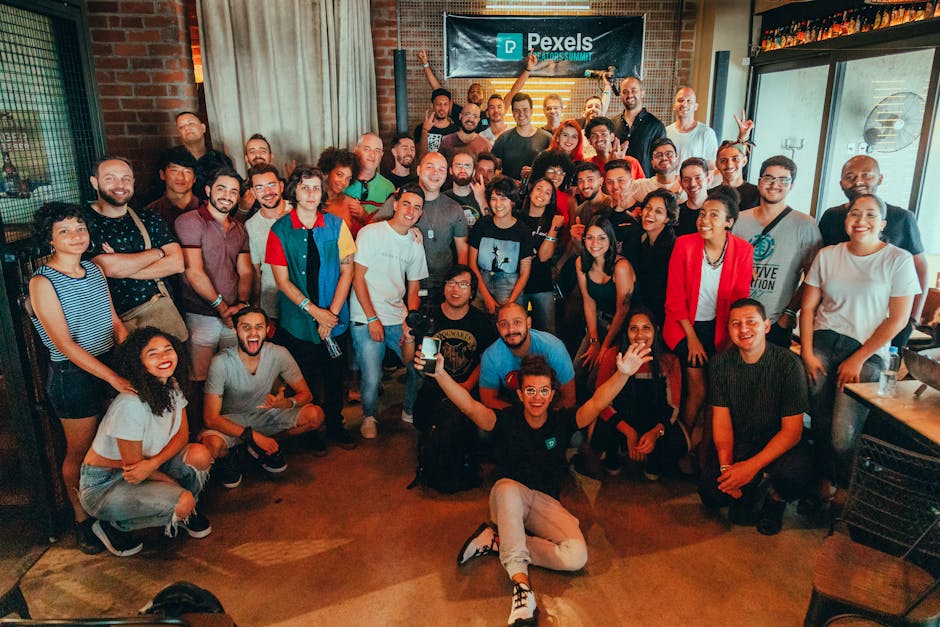- The Evolving Creator Economy: A New Paradigm of Income Generation
- The Creator Economy Market Landscape: Growth, Income, and Challenges
- Brand Deals and Sponsored Content: The Cornerstone of Creator Income
- Advertising Revenue: Leveraging Platform Reach for Consistent Income
- Subscriptions and Memberships: Building Sustainable Fan Communities
- Affiliate Marketing: Driving Sales Through Authentic Recommendations
- Own Brand and Merchandising: Diversifying Beyond Digital Content
- Platform Creator Funds and Rewards: Direct Payouts from Tech Giants
- Multi-Stream Monetization Strategy: Stacking Revenue for Resilience
- Data-Driven Content and Revenue Optimization: The Business of Creation
- Building Personal Brands as Full-Fledged Media Companies: The Ultimate Evolution
- Frequently Asked Questions (FAQ)
- Conclusion: Navigating the Future of Creator Monetization
The creator economy has rapidly transformed from a niche pursuit into a global economic powerhouse, offering unprecedented opportunities for individuals to monetize their passions and build thriving careers. As we move into 2025, understanding the most effective monetization strategies is paramount for creators aiming for sustainable growth and financial independence. This comprehensive guide delves into the top seven creators monetization methods, supported by the latest market data, expert insights, and real-world case studies.
From the dominance of brand deals to the rise of direct fan support and innovative digital products, we will explore how top creators are diversifying their income streams, optimizing their content, and building robust businesses. We’ll also highlight the critical shift towards strategies that offer higher returns on investment compared to traditional platform-dependent models, such as paid challenges, which often provide a more direct and substantial revenue path for creators.
The Evolving Creator Economy: A New Paradigm of Income Generation
The creator economy, valued at an estimated over $250 billion in 2023, is projected to reach $500 billion by 2027, reflecting its explosive growth and profound impact on global commerce and culture. This sector empowers individuals to leverage their unique skills, personalities, and content to generate income, fostering a new generation of entrepreneurs and media entities. The landscape is dynamic, with new platforms, tools, and monetization models emerging constantly, making it crucial for creators to stay informed and adaptable.
What Defines the Creator Economy?
The creator economy encompasses a diverse range of individuals who produce and distribute content, products, or services online, directly monetizing their audience. This includes YouTubers, TikTokers, Instagram influencers, podcasters, bloggers, online course instructors, and digital artists. The core principle is direct engagement with an audience, bypassing traditional gatekeepers and enabling creators to build personal brands and communities.
Why is Monetization Critical for Creators?
Monetization is the lifeblood of the creator economy, transforming passion projects into viable careers. Without effective strategies, creators risk burnout and financial instability. Sustainable monetization allows creators to invest in higher quality content, expand their teams, and ultimately, dedicate more time to their craft. It also fosters independence, reducing reliance on single platforms or volatile ad revenues.
Key Trends Shaping Creator Monetization in 2025
- Diversification of Income Streams: Creators are moving beyond single revenue sources, embracing a portfolio approach to income generation.
- Direct-to-Fan Monetization: A growing emphasis on subscriptions, memberships, and digital products that foster deeper fan relationships and higher revenue share.
- Data-Driven Decision Making: Savvy creators are using analytics to understand their audience, optimize content, and refine monetization strategies.
- Brand Partnerships Evolution: A shift towards more authentic, long-term brand collaborations that align with creator values and audience interests.
- Emergence of Web3 and NFTs: While still nascent, blockchain technologies offer new avenues for ownership, royalties, and fan engagement.
The Creator Economy Market Landscape: Growth, Income, and Challenges
The creator economy continues its upward trajectory, attracting millions of new participants annually. However, the distribution of wealth within this ecosystem remains highly skewed, highlighting the importance of strategic monetization. Understanding these dynamics is crucial for creators to set realistic expectations and develop effective business models.
Current State of Creator Income
While the overall market is booming, income distribution among creators is not uniform. According to Whop’s 2025 statistics, only 4% of creators globally earn over $100,000 per year, a decrease from 10% in 2022. This suggests increasing competition and a need for more sophisticated monetization strategies. The majority of creators fall into lower income brackets:
- 37% of creators make between $5,000 and $30,000 annually.
- 34% of creators make less than $5,000 annually.
- 20% of creators make between $30,000 and $100,000 annually.
In the US, content creators average around $44,000 per year, with top creators earning up to $74,500 per year. These figures underscore the challenge of achieving significant income solely through traditional platform monetization methods.
Challenges Faced by Creators
Despite the growth, creators face several hurdles:
- Algorithm Volatility: Sudden changes in platform algorithms can drastically impact reach and ad revenue.
- Burnout: The constant demand for new content and audience engagement can lead to exhaustion.
- Income Instability: Reliance on a single income stream (e.g., ad revenue) can lead to unpredictable earnings.
- Platform Dependence: Creators are often at the mercy of platform policies, fees, and revenue share models.
- Monetization Ceiling: Many traditional platform monetization methods, like ad revenue, have a ceiling that requires an exponential increase in views or followers to achieve significant income. For example, generating $20,000 from YouTube ad revenue alone might require millions of views, which is a monumental task for most creators.
The Shift Towards Higher ROI Monetization
Given these challenges, there’s a growing recognition that traditional platform-based monetization (like ad revenue or small creator funds) often doesn’t reflect the true investment of time and effort by creators. This is why more creators and businesses are turning to higher ROI strategies, such as paid challenges, online courses, and exclusive communities. These models allow creators to generate substantial income with a smaller, more engaged audience.
For instance, to generate $20,000, a creator might only need 200 people to join a paid challenge at $99 each. This is significantly easier to achieve than accumulating the massive viewership required for equivalent ad revenue on platforms like YouTube. Platforms like Communipass are emerging as all-in-one solutions for creators to host such challenges and build direct monetization funnels, often offering free starting tiers to facilitate this transition.
| Annual Income Range | Percentage of Creators | Key Monetization Focus |
|---|---|---|
| Less than $5,000 | 34% | Ad Revenue, Small Affiliate Sales, Tips |
| $5,000 – $30,000 | 37% | Growing Brand Deals, Affiliate Marketing, Basic Subscriptions |
| $30,000 – $100,000 | 20% | Consistent Brand Deals, Digital Products, Tiered Subscriptions |
| Over $100,000 | 4% | Major Brand Partnerships, Courses, High-Value Digital Products, Merch |

Brand Deals and Sponsored Content: The Cornerstone of Creator Income
Brand deals and sponsored content remain the most lucrative monetization strategy for creators, accounting for a significant portion of their earnings. In 2023, brand deals represented 70% of creator revenue, solidifying their position as the primary income source. This method involves creators partnering with brands to promote products or services to their audience, leveraging their influence and authenticity.
Understanding Brand Partnerships
Brand deals can take various forms, from single sponsored posts to long-term ambassador programs. They typically involve a direct payment from the brand to the creator in exchange for content creation and distribution. The value of a brand deal is influenced by factors such as audience size, engagement rates, niche relevance, and the creator’s past performance in driving results for brands.
Earning Potential from Brand Deals
The earning potential from brand deals varies widely based on follower count and platform. According to Fundmates’ 2025 data, average brand collaboration rates are:
- 500+ followers: $10–$100 per post
- 10,000+ followers: $100–$500 per post
- 100,000+ followers: $1,000–$5,000 per post
- 500,000+ followers: $3,000–$10,000 per post
- 1,000,000+ followers: $50,000+ per post
Top creators like Charli D’Amelio can earn over $100,000 per post on TikTok, while MrBeast, the highest earner on Forbes’ 2022 list, made $54 million primarily through YouTube and sponsorships.
Best Practices for Securing and Maximizing Brand Deals
- Build an Engaged Niche Audience: Brands seek creators whose audience aligns with their target demographic. A smaller, highly engaged niche audience is often more attractive than a large, general one.
- Create a Professional Media Kit: This document should showcase your audience demographics, engagement rates, past brand collaborations, and content examples.
- Proactively Pitch Brands: Don’t wait for brands to come to you. Identify brands that align with your content and audience, and craft personalized pitches.
- Negotiate Fair Compensation: Understand your worth and be prepared to negotiate. Consider not just monetary compensation but also product value and long-term partnership potential.
- Deliver High-Quality Content: Ensure sponsored content is authentic, engaging, and seamlessly integrated into your regular content style to maintain audience trust.
- Provide Performance Reports: After a campaign, share data on reach, engagement, and conversions to demonstrate ROI for the brand, increasing the likelihood of future collaborations.

Advertising Revenue: Leveraging Platform Reach for Consistent Income
Advertising revenue, primarily generated through platform-specific ad programs, remains a foundational income stream for many creators. While often requiring significant viewership to generate substantial income, it provides a consistent, passive revenue stream for creators with large and active audiences. Platforms like YouTube and Twitch are key players in this space, sharing a portion of their ad revenue with content creators.
How Advertising Revenue Works
Platforms display ads before, during, or after a creator’s content. A portion of the revenue generated from these ads is then shared with the creator. The exact payout depends on various factors, including ad formats, audience demographics, ad viewability, and advertiser demand. This model incentivizes creators to produce engaging content that attracts and retains viewers, thereby increasing ad impressions.
Major Platforms and Their Ad Revenue Models
- YouTube: YouTube shares 55% of its ad revenue with creators through its YouTube Partner Program. This has led to significant payouts, with the platform’s total payout growth reaching $3.23 billion in 2024, up from $2.34 billion in 2021. Historically, YouTube’s total payouts to creators have exceeded $50 billion.
- Twitch: While Twitch primarily focuses on subscriptions, it also offers ad revenue to streamers. Streamers can run ads during their broadcasts, earning a share of the revenue generated.
- Facebook/Instagram: These platforms offer various ad monetization options for video content and Reels, though their revenue share models can be more complex and often less transparent than YouTube’s.
Strategies to Maximize Ad Revenue
- Increase Watch Time: Longer videos and higher audience retention directly translate to more ad impressions and higher revenue. Focus on creating compelling content that keeps viewers engaged.
- Optimize Ad Placements: For platforms like YouTube, strategically placing mid-roll ads in longer videos can significantly boost earnings without disrupting the viewer experience too much.
- Understand Your Audience Demographics: Advertisers often pay more for certain demographics. Tailoring content to attract high-value audiences can increase your CPM (Cost Per Mille, or cost per thousand views).
- Maintain Content Quality and Consistency: Regular uploads of high-quality content help grow and retain an audience, leading to consistent ad revenue.
- Diversify Content Formats: Experiment with different video lengths and styles to see what performs best for ad monetization.
While ad revenue can be a stable income source, it often requires massive scale. For many creators, the effort-to-reward ratio can be low compared to direct monetization methods like paid challenges or digital products. This is why it’s often seen as a baseline income, supplemented by more lucrative strategies.
Subscriptions and Memberships: Building Sustainable Fan Communities
Subscriptions and memberships represent a powerful shift towards direct-to-fan monetization, offering creators a more stable and predictable income stream. By providing exclusive content, perks, or access to a community, creators can cultivate deeper relationships with their most dedicated fans, who are willing to pay for premium experiences. This model fosters independence from volatile ad revenues and algorithm changes.
The Power of Direct Fan Support
Unlike ad revenue, which scales with viewership, subscriptions scale with fan loyalty. A smaller, highly engaged audience can generate significant income through recurring payments. This model empowers creators to focus on serving their core community rather than chasing viral trends, leading to more authentic and sustainable content creation.
Leading Subscription Platforms and Their Models
- Patreon: Patreon is a leading platform for creators to offer tiered memberships with exclusive benefits. Creators typically retain 88-92% of pledges after platform fees, making it a major revenue channel for many. Benefits can include early access to content, exclusive behind-the-scenes footage, private Discord channels, or one-on-one interactions.
- Twitch: Twitch offers channel subscriptions, allowing viewers to support their favorite streamers with recurring payments. Twitch typically splits subscription revenue 50/50 with creators, though top-tier streamers may negotiate higher splits. Subscribers often receive custom emotes, ad-free viewing, and special badges.
- YouTube Memberships: Similar to Patreon, YouTube allows creators to offer channel memberships with exclusive perks like custom emojis, loyalty badges, and members-only content.
- Substack: For writers and journalists, Substack enables paid newsletters, offering a direct subscription model for written content.
- Communipass: Emerging platforms like Communipass are designed specifically for hosting paid challenges and community memberships, providing an all-in-one solution for creators to build and monetize their direct communities.
Strategies for Successful Subscription Models
- Define Clear Value Propositions: Clearly articulate what subscribers will gain at each tier. What exclusive content, access, or community benefits are you offering?
- Offer Tiered Options: Provide multiple subscription tiers at different price points to cater to various fan budgets and levels of commitment.
- Consistently Deliver Exclusive Content: To retain subscribers, regularly provide high-quality, exclusive content or experiences that justify the recurring payment.
- Foster Community: Create a sense of belonging among your subscribers through private forums, Q&A sessions, or exclusive events.
- Promote Your Membership: Regularly remind your audience about your subscription options and the value they offer, without being overly pushy.
Case Study: A chef influencer, after building a large audience on TikTok with free recipe videos, successfully converted a segment of her superfans into paid subscribers on Patreon. She offers tiered memberships, including exclusive long-form cooking courses, monthly live Q&As, and a private recipe testing community. This multi-stream approach allows her to monetize highly engaged fans beyond ad revenue.

Affiliate Marketing: Driving Sales Through Authentic Recommendations
Affiliate marketing has emerged as a significant and growing revenue stream for creators, allowing them to earn commissions by promoting products or services from other companies. This method leverages a creator’s influence to drive sales, with creators receiving a percentage of each sale made through their unique affiliate link. In 2024, creators earned $1.1 billion from affiliate marketing, nearly doubling from $570 million in 2021, highlighting its rapid expansion and effectiveness.
How Affiliate Marketing Works for Creators
Creators sign up for affiliate programs offered by brands or through affiliate networks (e.g., Amazon Associates, ShareASale, RewardStyle). They then receive unique tracking links or codes. When their audience clicks these links and makes a purchase, the creator earns a commission. This model is performance-based, meaning creators only earn when a sale is made, incentivizing authentic recommendations and effective promotion.
Key Trends in Affiliate Marketing for Creators
- Platform Integration: Platforms like TikTok are piloting programs that enable affiliate revenue for creators with as few as 1,000 followers, making it accessible to micro-influencers.
- Authenticity Over Hard Sell: Audiences are increasingly wary of overt advertising. Successful affiliate marketing relies on genuine product reviews, tutorials, and recommendations that naturally integrate into content.
- Data-Driven Optimization: Savvy creators use UTM links and dashboards to track performance, identify top-converting products, and optimize their affiliate strategies.
- Gen Z Adoption: Gen Z creators, in particular, are relying on affiliate marketing as a core, direct-pay monetization model.
Strategies for Maximizing Affiliate Income
- Choose Relevant Products: Only promote products or services that genuinely align with your niche and that you would personally use and recommend. Inauthenticity quickly erodes audience trust.
- Create Engaging Content: Don’t just drop a link. Create compelling reviews, tutorials, comparison videos, or “how-to” guides that showcase the product’s value.
- Utilize Multiple Platforms: Share affiliate links across your blog, YouTube descriptions, Instagram stories (swipe-up links), TikTok bios, and email newsletters.
- Disclose Affiliate Relationships: Transparency is crucial. Always clearly disclose your affiliate relationship to your audience, as required by law and for maintaining trust.
- Track and Analyze Performance: Regularly review your affiliate dashboard to see which products and content formats are generating the most sales. Use this data to refine your strategy.
Example: A beauty influencer creates a “My Top 5 Skincare Must-Haves” video on YouTube. In the description, she includes Amazon affiliate links for each product. When viewers click these links and purchase, she earns a commission. She also uses RewardStyle links for fashion items on her Instagram, integrating them into her daily outfit posts.
Own Brand and Merchandising: Diversifying Beyond Digital Content
Building an “own brand” and launching merchandise or physical products represents a significant step for creators looking to diversify their income beyond digital content and platform reliance. While this channel accounted for less than 5% of overall creator income in 2023, it offers substantial long-term potential for brand building, direct revenue, and deeper fan engagement. It transforms a creator into a true entrepreneur with tangible assets.
The Strategic Value of an Own Brand
An own brand allows creators to:
- Increase Revenue Margins: Unlike platform ad revenue or even some brand deals, selling your own products offers higher profit margins.
- Build Brand Equity: Merchandise extends a creator’s brand identity into the physical world, fostering stronger recognition and loyalty.
- Deepen Fan Connection: Fans often purchase merchandise as a way to show support and feel more connected to their favorite creators.
- Diversify Income: Reduces reliance on single platforms or volatile income streams, providing a more stable financial foundation.
- Create New Business Ventures: Successful merchandise lines can evolve into standalone businesses, as seen with MrBeast’s ventures.
Types of Own Brand Products and Merchandise
- Apparel: T-shirts, hoodies, hats, and other clothing items featuring creator logos, catchphrases, or unique designs.
- Digital Products: E-books, presets (for photographers/videographers), templates, digital art, or exclusive music tracks.
- Physical Products: Beyond apparel, this can include custom stationery, home goods, beauty products, or even food items. MrBeast’s highly successful “MrBeast Burger” chain is a prime example of a creator extending their brand into a physical product and service.
- Online Courses/Workshops: Leveraging expertise to teach a skill or provide in-depth knowledge, often at a premium price point.
- Subscription Boxes: Curated boxes of products related to the creator’s niche, delivered to subscribers regularly.
Implementation Strategies for Own Brand Success
- Identify Your Niche and Audience Demand: What products would genuinely resonate with your specific audience? Conduct polls or surveys to gauge interest.
- Focus on Quality: Poor quality merchandise can damage your brand. Partner with reputable manufacturers and ensure products meet high standards.
- Leverage Print-on-Demand (POD) Services: For apparel and simple products, POD services (e.g., Printful, Teespring) minimize upfront costs and inventory risk.
- Build an E-commerce Store: Platforms like Shopify, Etsy, or even a dedicated section on your website are essential for selling products directly.
- Promote Authentically: Integrate your products naturally into your content. Wear your merchandise, use your digital products, and share behind-the-scenes glimpses of the creation process.
Case Study: MrBeast, a renowned YouTuber, not only earns millions from ad revenue and sponsorships but has also successfully launched “MrBeast Burger,” a virtual restaurant chain, and Feastables, a snack brand. These ventures demonstrate how a strong personal brand can be leveraged to create highly profitable physical products and services, transcending traditional digital content monetization.

Platform Creator Funds and Rewards: Direct Payouts from Tech Giants
In an effort to attract and retain top talent, major social media platforms have introduced creator funds and reward programs, offering direct payouts to creators based on performance metrics. These funds serve as an incentive for creators to produce engaging content specifically for their platforms, supplementing other monetization methods. While they can provide a valuable income boost, their payout structures can vary significantly and are often less predictable than other revenue streams.
How Creator Funds Operate
Creator funds typically distribute a pool of money among eligible creators based on factors such as views, engagement, content quality, and adherence to platform guidelines. The goal is to reward creators for their contributions to the platform’s ecosystem and to encourage continued content creation. These funds often target specific content formats, like short-form video, or emerging creators.
Examples of Major Platform Funds
- TikTok Creator Rewards: TikTok’s program pays creators between $0.40 and $1.00 per 1,000 views. The average TikTok creator income in 2025 can range widely, from $25–$125 per post for 1K–10K followers to $10,000+ per post for 1M+ followers.
- YouTube Shorts Fund: YouTube introduced a fund to reward creators for popular Shorts videos, recognizing the growth of short-form content.
- Snapchat Spotlight: Snapchat has historically offered significant payouts for viral content submitted to its Spotlight feature.
- Facebook Reels Play Bonus Program: Meta offers bonuses to eligible creators whose Reels perform well on Facebook and Instagram.
Considerations and Strategies for Creator Funds
- Understand Eligibility Requirements: Each fund has specific criteria (e.g., minimum follower count, view thresholds, content originality). Ensure your content meets these requirements.
- Focus on Platform-Specific Trends: Tailor your content to what performs well on the specific platform offering the fund. For TikTok, this means short, engaging, trending videos.
- Prioritize Engagement: While views are important, engagement (likes, comments, shares) often plays a role in how content is valued by these funds.
- Monitor Payout Structures: Payout rates can fluctuate based on platform budgets, overall content volume, and algorithm changes. Do not rely solely on these funds for income.
- Diversify Beyond Funds: Creator funds should be seen as supplementary income. They are often unpredictable and can be phased out or reduced, making diversification essential.
While platform funds offer a direct path to monetization, they are often designed to be a starting point or a bonus, rather than a primary, sustainable income source. The payment per view or engagement can be relatively low, meaning creators need massive scale to earn significant amounts. This reinforces the argument for exploring higher-yield monetization strategies like paid challenges and digital products, which offer more control and better returns on effort.
Multi-Stream Monetization Strategy: Stacking Revenue for Resilience
The most successful creators in 2025 are not relying on a single income stream but are strategically stacking multiple monetization methods. This “multi-stream” approach builds financial resilience, reduces dependence on any one platform or revenue source, and maximizes overall earning potential. It’s about treating content creation as a comprehensive business with diverse revenue channels.
Why Multi-Stream Monetization is Essential
- Risk Mitigation: If one income stream (e.g., ad revenue) declines due to algorithm changes or market shifts, other streams can compensate.
- Increased Income Potential: Combining several smaller revenue streams can collectively generate a substantial income.
- Audience Segmentation: Different monetization methods cater to different segments of your audience (e.g., casual viewers vs. superfans).
- Sustainable Growth: Diversified income allows for reinvestment into content quality, team expansion, and new ventures.
- Enhanced Control: Less reliance on a single platform’s policies or payout structures.
Core Components of a Multi-Stream Strategy
- Discovery Funnel (e.g., TikTok, Instagram Reels): Use short-form, viral content platforms to attract new audiences. These platforms are excellent for reach but often have lower direct monetization per view.
- Engagement Hub (e.g., YouTube, Blog, Podcast): Direct engaged followers to platforms where you can provide deeper value and monetize through ads, longer-form content, or affiliate links.
- Direct Monetization (e.g., Patreon, Courses, Paid Challenges): Convert your most loyal fans into paying customers through subscriptions, digital products, or exclusive experiences. This is where the highest per-fan value is realized.
- Brand Partnerships: Integrate sponsored content across your platforms, leveraging your entire audience for lucrative deals.
- Merchandise/Own Products: Offer physical or digital products that deepen brand loyalty and provide high-margin revenue.
Case Studies in Multi-Stream Success
- Gaming YouTuber: This creator uses YouTube ad revenue as a base income. They then drive their most dedicated fans to a Patreon with tiered memberships offering exclusive gameplay, early access to videos, and private Discord access. They also secure brand deals for gaming peripherals and integrate affiliate links for games they review.
- Fitness Influencer: She uses Instagram Reels and TikTok for viral workout snippets (discovery). Her YouTube channel features full workout routines (engagement and ad revenue). She then sells personalized workout plans and nutrition guides (digital products) through her website and hosts paid fitness challenges on a platform like Communipass, offering direct, high-value monetization.
- Educational Content Creator: This creator uses free YouTube tutorials to attract students (discovery and ad revenue). They then offer comprehensive online courses (digital products) on platforms like Teachable or Thinkific. They also run a paid newsletter on Substack for advanced topics and exclusive insights.
This stacking of revenue streams is considered the smartest approach for sustainable growth, ensuring creators are not vulnerable to the whims of a single platform or market trend. It’s about building a robust, diversified business model around your content and community.
Data-Driven Content and Revenue Optimization: The Business of Creation
In 2025, successful creators are increasingly adopting a business mindset, moving beyond viral luck to embrace data-driven strategies for content creation and revenue optimization. This involves leveraging analytics, tracking performance metrics, and systematically calibrating content and monetization efforts to ensure predictable income growth across all channels. It transforms content creation from a hobby into a sophisticated, scalable enterprise.
Why Data is the Creator’s Best Friend
- Understand Audience Behavior: Analytics reveal what content resonates, when your audience is most active, and how they engage.
- Identify Monetization Opportunities: Data can highlight which products sell best, which affiliate links convert, and which membership tiers are most popular.
- Optimize Content Strategy: Insights into watch time, click-through rates, and audience demographics inform future content decisions.
- Improve ROI on Efforts: By tracking performance, creators can allocate their time and resources to the most effective content and monetization strategies.
- Negotiate Better Deals: Concrete data on audience engagement and past campaign performance provides leverage in brand deal negotiations.
Key Data Points and Tools for Creators
- Platform Analytics: YouTube Studio, TikTok Analytics, Instagram Insights, and Twitch Creator Dashboard provide invaluable data on views, watch time, audience demographics, engagement rates, and traffic sources.
- Website Analytics (e.g., Google Analytics): If you have a website or blog, these tools track user behavior, traffic sources, and conversion rates for your digital products or affiliate links.
- Affiliate Dashboards: Affiliate networks provide detailed reports on clicks, conversions, and earnings for each product or link.
- Email Marketing Metrics: Track open rates, click-through rates, and conversion rates for your email campaigns promoting products, memberships, or challenges.
- CRM/Audience Management Tools: Tools that help segment your audience and track their interactions, informing personalized content and offers.
- UTM Tracking: Use UTM parameters in your links to track the effectiveness of different promotional channels and campaigns.
Implementing a Data-Driven Approach
- Set Clear Goals: Define what success looks like for each content piece or monetization effort (e.g., “increase YouTube watch time by 10%”, “sell 50 spots in the next paid challenge”).
- Regularly Review Analytics: Dedicate time weekly or monthly to dive into your data. Look for trends, anomalies, and actionable insights.
- A/B Test Content and Offers: Experiment with different video titles, thumbnails, call-to-actions, or product pricing to see what performs best.
- Create Content Briefs: Before creating content, outline the target audience, key message, desired outcome, and how it will contribute to your monetization goals.
- Systematize Feedback Loops: Use data to inform your next content batch or product launch. If a certain type of video performs well, create more of it. If a product isn’t selling, analyze why and adjust your strategy.
By applying business intelligence (BI) dashboards and real-time campaign calibration, creators can convert every post or livestream into a revenue-generating node rather than relying on viral luck. This strategic approach ensures predictable income growth across channels and methods, moving creators towards a more stable and profitable future.
Building Personal Brands as Full-Fledged Media Companies: The Ultimate Evolution
The ultimate evolution for top creators is to transcend individual content creation and establish their personal brand as a full-fledged media company. This involves operating with intentionality, strategic planning, sales funnels, ROI measurement, and a mindset akin to a marketing or product manager. It transforms content from a hobby or a series of individual projects into a scalable, sustainable business entity with diverse revenue streams and long-term vision.
The Vision of a Creator as a Media Company
This paradigm shift means:
- Strategic Content Planning: Content is produced not just for engagement but as part of a larger strategy to build audience, drive conversions, and support various monetization funnels.
- Team Building: Hiring editors, social media managers, business development leads, and even legal counsel to manage operations.
- Product Development: Creating and launching digital products, physical merchandise, or services (like coaching or consulting) under the brand’s umbrella.
- Marketing and Sales Funnels: Implementing sophisticated strategies to convert audience members into paying customers, often through email lists, webinars, or direct sales pages.
- Brand Partnerships as Collaborations: Moving beyond transactional sponsored posts to co-created brand partnerships with transparent licensing and fair compensation.
- Long-Term Asset Building: Focusing on building intellectual property, a loyal customer base, and a diversified portfolio of income-generating assets.
Characteristics of a Creator-Led Media Company
- Authenticity and Co-Creation: While operating as a business, the core remains the creator’s authentic voice and connection with their audience. Co-creation with the community is often a hallmark.
- Scalability: Systems and processes are put in place to allow the brand to grow beyond the individual creator’s direct output.
- Diversified Portfolio: Multiple revenue streams (ads, sponsorships, subscriptions, digital products, physical goods, events, services) are actively managed.
- Data-Driven Decisions: Every aspect of the business, from content performance to product sales, is tracked and analyzed to inform strategy.
- Community as a Core Asset: The audience is not just viewers but a valuable community that can be engaged, nurtured, and monetized ethically.
Examples of Creators Building Media Companies
- MrBeast (Jimmy Donaldson): Beyond his YouTube channel, he has built a massive enterprise including MrBeast Burger, Feastables (snack brand), and various philanthropic initiatives. His content serves as a marketing engine for these ventures.
- Huda Kattan (Huda Beauty): Started as a beauty blogger, she transformed her personal brand into a multi-billion dollar cosmetics company, demonstrating the power of leveraging influence into product lines.
- Gary Vaynerchuk (VaynerMedia): A pioneer in digital marketing, Gary Vaynerchuk built a media empire around his personal brand, offering marketing services, investing in startups, and producing vast amounts of content.
This strategic evolution emphasizes that the true potential of the creator economy lies not just in individual content pieces, but in the intentional construction of a sustainable, multi-faceted business. It’s a testament to the fact that creators are no longer just entertainers or influencers; they are the new wave of media moguls.
Frequently Asked Questions (FAQ)
How do I start monetizing my content as a new creator?
Start by building an engaged audience in a specific niche. For monetization, begin with accessible methods like affiliate marketing, especially on platforms like TikTok that allow it with as few as 1,000 followers. As your audience grows, explore brand deals and direct fan support.
Key steps for new creators:
- Choose a Niche: Focus on a specific topic or audience to build authority.
- Consistently Create Value: Produce high-quality, engaging content regularly.
- Engage with Your Audience: Respond to comments, ask questions, and build a community.
- Explore Affiliate Programs: Promote products you genuinely use and love.
- Consider Paid Challenges: Even with a smaller audience, a well-structured paid challenge can provide significant income.
What are the most profitable monetization methods for creators in 2025?
Brand deals and sponsorships are currently the most profitable, accounting for 70% of creator revenue in 2023. However, direct-to-fan monetization like paid challenges, online courses, and subscriptions offer higher profit margins and greater control over income.
Top profitable methods:
- Brand Deals/Sponsorships: High payouts for established creators.
- Paid Challenges/Digital Products: High profit margins, direct fan monetization.
- Subscriptions/Memberships: Stable recurring income from loyal fans.
- Own Brand/Merchandise: Builds long-term brand equity and high margins.
Why should creators diversify their income streams?
Diversifying income streams is crucial for financial stability and long-term sustainability. It mitigates risks associated with algorithm changes, platform policy shifts, or fluctuations in a single revenue source like ad revenue, ensuring a more predictable income.
Benefits of diversification:
- Risk Mitigation: Reduces vulnerability to changes in one income source.
- Increased Income: Combines multiple revenue streams for higher overall earnings.
- Greater Control: Less dependence on platform whims and external factors.
- Sustainable Growth: Allows for reinvestment and expansion of the creator’s business.
When to consider launching a paid community or digital product?
Consider launching a paid community or digital product once you have a loyal, engaged audience who consistently seeks more in-depth content or direct interaction. This typically happens after you’ve established your expertise and built trust through free content.
Ideal timing indicators:
- Consistent engagement and requests for more specific content.
- A growing email list or direct messaging interactions.
- When you can identify a clear problem your audience has that you can solve with a premium offering.
- When you want to reduce reliance on ad revenue or brand deals.
What is the role of data analytics in creator monetization?
Data analytics is fundamental for optimizing content and revenue. It helps creators understand audience behavior, identify top-performing content, track monetization effectiveness, and make informed decisions to maximize earnings and growth. It shifts creators from relying on luck to strategic business operations.
Key uses of data:
- Audience Insights: Demographics, interests, and engagement patterns.
- Content Performance: Views, watch time, retention, and virality.
- Monetization Tracking: Affiliate link clicks, product sales, subscription conversions.
- Strategic Planning: Informing future content, product development, and marketing efforts.
How do paid challenges offer a better ROI than traditional platform monetization?
Paid challenges offer a significantly better ROI because they require a smaller, highly engaged audience to generate substantial income. For example, earning $20,000 from a challenge at $99 per person only requires 200 participants, whereas achieving the same income from YouTube ads would demand millions of views, a much harder feat.
Advantages of paid challenges:
- Higher Per-Fan Value: Direct payment from engaged fans.
- Lower Audience Threshold: Significant income with a smaller, dedicated community.
- Direct Relationship: Builds stronger connections with paying customers.
- Control Over Revenue: Less dependent on platform algorithms or ad rates.
What is the average income for content creators in the US?
In the US, content creators average around $44,000 per year, with top creators earning up to $74,500 per year. However, income distribution is highly skewed, with only 4% of global creators earning over $100,000 annually.
Income breakdown:
- 34% make less than $5,000
- 37% make between $5,000 and $30,000
- 20% make between $30,000 and $100,000
- 4% make over $100,000
How can creators build a personal brand into a media company?
Building a personal brand into a media company involves a strategic shift from individual content creation to operating with a business mindset. This includes diversifying revenue streams, building a team, developing proprietary products, implementing sales funnels, and leveraging data for strategic decision-making, much like MrBeast has done with his various ventures.
Key steps:
- Diversify Revenue: Combine ads, sponsorships, subscriptions, and products.
- Build a Team: Delegate tasks like editing, social media management, and business development.
- Develop Products: Create your own merchandise, digital products, or services.
- Implement Sales Funnels: Guide your audience towards paid offerings.
- Use Data: Track performance to inform business decisions.
What role do platforms like Communipass play in creator monetization?
Platforms like Communipass are crucial for creators looking to move beyond traditional ad revenue by offering all-in-one solutions for hosting paid challenges, online courses, and building direct communities. They simplify the technical aspects of direct monetization, allowing creators to focus on content and audience engagement, often with free starting tiers to facilitate entry.
Benefits of such platforms:
- Direct Monetization: Facilitate sales of courses, challenges, and memberships.
- Community Building: Provide tools for engaging with paying members.
- Reduced Technical Overhead: Handle payments, hosting, and delivery.
- Higher Profit Margins: Creators retain a larger share of revenue compared to ad-based models.
What are the emerging trends in creator monetization for 2025?
Emerging trends include the increasing adoption of multi-stream monetization strategies, a stronger focus on direct-to-fan models like paid challenges and digital products, and the strategic use of data analytics to optimize revenue. Additionally, the evolution of creators into full-fledged media companies is a significant trend, as highlighted by TS2 Tech’s 2025-2026 Content Monetization Gold Rush report.
Key emerging trends:
- Multi-Stream Revenue: Stacking various income sources.
- Direct-to-Fan Models: Subscriptions, paid challenges, digital products.
- Data-Driven Optimization: Using analytics for strategic decisions.
- Creator as Media Company: Building scalable businesses around personal brands.
- Web3 and NFTs: New avenues for ownership and fan engagement (still early).
How can micro-influencers effectively monetize their content?
Micro-influencers, despite smaller follower counts, can effectively monetize by focusing on highly engaged niche audiences. Strategies include targeted affiliate marketing (some platforms allow this with as few as 1,000 followers), micro-brand deals that value authenticity over reach, and direct-to-fan models like paid challenges or exclusive content for a dedicated few.
Effective micro-influencer strategies:
- Niche Focus: Attract brands looking for specific audiences.
- High Engagement: Brands value engagement over follower count.
- Affiliate Marketing: Promote relevant products with genuine recommendations.
- Direct Support: Offer exclusive content or services to superfans.
- Paid Challenges: Monetize expertise directly to a small, dedicated group.
What are the common pitfalls creators should avoid in monetization?
Creators should avoid over-reliance on a single income stream, neglecting audience engagement, compromising authenticity for quick cash, and failing to understand their analytics. Not diversifying or investing in higher ROI models like paid challenges can lead to burnout and limited growth.
Pitfalls to avoid:
- Single Income Stream: High risk of instability.
- Ignoring Analytics: Missed opportunities for optimization.
- Loss of Authenticity: Damages audience trust and long-term brand.
- Poor Financial Planning: Not reinvesting or saving.
- Underestimating Value: Accepting low payouts for high effort.
How important is audience engagement for monetization?
Audience engagement is paramount for monetization. High engagement signals a loyal and active community, which is attractive to brands for sponsorships and more likely to convert into paying subscribers or customers for digital products. It’s often valued more than sheer follower count by savvy brands and platforms.
Impact of engagement:
- Brand Deals: Brands seek engaged audiences for better ROI.
- Subscriptions: Engaged fans are more likely to subscribe.
- Affiliate Sales: Trust built through engagement drives conversions.
- Community Building: Fosters a loyal base for direct monetization.
What are the future prospects for the creator economy?
The creator economy is projected to continue its rapid growth, potentially reaching $500 billion by 2027. Future prospects include further diversification of monetization models, increased professionalization of creators, integration of Web3 technologies, and a stronger emphasis on direct-to-consumer relationships and high-value offerings like paid challenges and digital products.
Future outlook:
- Continued Growth: Market size expected to double.
- Professionalization: More creators operating as businesses.
- Direct Monetization Dominance: Shift away from ad-centric models.
- Technological Integration: Web3, AI, and new platforms.
- Niche Specialization: Deeper engagement within specific communities.
How can creators ensure authenticity while monetizing?
Authenticity is key to long-term success. Creators can ensure it by only promoting products or services they genuinely believe in and use, clearly disclosing all sponsored content and affiliate relationships, and prioritizing their audience’s trust over short-term gains. This builds a loyal community that values your recommendations.
Maintaining authenticity:
- Genuine Recommendations: Only promote what you truly endorse.
- Transparency: Always disclose sponsored content and affiliate links.
- Audience First: Prioritize your community’s needs and trust.
- Consistent Voice: Stay true to your personal brand and values.
What is the “volume strategy” in creator monetization?
The “volume strategy” refers to stacking multiple monetization layers, using platforms like TikTok or Instagram for discovery and then funneling engaged audiences to other platforms (like YouTube, Twitch, or paid memberships) for higher monetization per engagement. It’s about optimizing each platform’s strength in a multi-platform funnel, as described by Fundmates.
Components of the volume strategy:
- Discovery Platforms: TikTok, Instagram Reels for reach.
- Engagement Platforms: YouTube, blogs for deeper content.
- Direct Monetization: Patreon, courses, paid challenges for high-value transactions.
- Layered Income: Combining ad revenue, sponsorships, affiliates, and direct sales.
Conclusion: Navigating the Future of Creator Monetization
The creator economy is a dynamic and rapidly expanding landscape, offering immense opportunities for individuals to build lucrative careers from their passions. As we’ve explored, the top 7 creators monetization strategies for 2025 emphasize diversification, direct-to-fan engagement, and a data-driven business mindset. While traditional methods like brand deals and advertising revenue remain significant, the future increasingly belongs to creators who strategically stack multiple income streams, build strong communities, and offer high-value digital products or experiences.
The shift towards models like paid challenges, online courses, and exclusive memberships is particularly noteworthy. These methods offer a significantly higher return on investment compared to the often-modest payouts from platform ad revenue, allowing creators to achieve substantial income with a smaller, more dedicated audience. Platforms like Communipass are at the forefront of enabling this transition, providing the tools necessary for creators to take control of their monetization journey and build truly sustainable businesses.
Ultimately, success in the evolving creator economy hinges on adaptability, authenticity, and a willingness to treat content creation as a professional enterprise. By embracing these strategies and continuously learning from data, creators can not only monetize their content effectively but also build lasting personal brands that transcend fleeting trends and algorithm changes, transforming into full-fledged media companies of the future.








